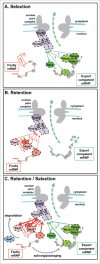Intron or no intron: a matter for nuclear pore complexes
- PMID: 26709543
- PMCID: PMC4915510
- DOI: 10.1080/19491034.2015.1116660
Intron or no intron: a matter for nuclear pore complexes
Abstract
Nuclear pore complexes (NPCs) have been shown to regulate distinct steps of the gene expression process, from transcription to mRNA export. In particular, mRNAs expressed from intron-containing genes are surveyed by a specific NPC-dependent quality control pathway ensuring that unspliced mRNAs are retained within the nucleus. In this Extra View, we summarize the different approaches that have been developed to evaluate the contribution of various NPC components to the expression of intron-containing genes. We further present the mechanistic models that could account for pre-mRNA retention at the nuclear side of NPCs. Finally, we discuss the possibility that other stages of intron-containing gene expression could be regulated by nuclear pores, in particular through the regulation of mRNA biogenesis factors by the NPC-associated SUMO protease Ulp1.
Keywords: SUMO-protease Ulp1; THO/TREX complex; mRNA export; mRNA quality control; mRNA transcription; nuclear pore complexes; sumoylation.
Figures


Comment on
- doi: 10.1093/nar/gkv280
Similar articles
-
Nuclear pore components affect distinct stages of intron-containing gene expression.Nucleic Acids Res. 2015 Apr 30;43(8):4249-61. doi: 10.1093/nar/gkv280. Epub 2015 Apr 6. Nucleic Acids Res. 2015. PMID: 25845599 Free PMC article.
-
A nuclear envelope protein linking nuclear pore basket assembly, SUMO protease regulation, and mRNA surveillance.J Cell Biol. 2007 Aug 27;178(5):813-27. doi: 10.1083/jcb.200702154. J Cell Biol. 2007. PMID: 17724121 Free PMC article.
-
Ulp1 association with nuclear pore complexes is required for the maintenance of global SUMOylation.Mol Biol Cell. 2025 Jul 1;36(7):ar81. doi: 10.1091/mbc.E24-12-0563. Epub 2025 May 6. Mol Biol Cell. 2025. PMID: 40327319
-
mRNA export and gene expression: the SAGA-TREX-2 connection.Biochim Biophys Acta. 2012 Jun;1819(6):555-65. doi: 10.1016/j.bbagrm.2011.11.011. Epub 2011 Dec 8. Biochim Biophys Acta. 2012. PMID: 22178374 Review.
-
Into the basket and beyond: the journey of mRNA through the nuclear pore complex.Biochem J. 2020 Jan 17;477(1):23-44. doi: 10.1042/BCJ20190132. Biochem J. 2020. PMID: 31913454 Review.
Cited by
-
Structure, Maintenance, and Regulation of Nuclear Pore Complexes: The Gatekeepers of the Eukaryotic Genome.Cold Spring Harb Perspect Biol. 2022 Mar 1;14(3):a040691. doi: 10.1101/cshperspect.a040691. Cold Spring Harb Perspect Biol. 2022. PMID: 34312247 Free PMC article. Review.
-
A nuclear pore sub-complex restricts the propagation of Ty retrotransposons by limiting their transcription.PLoS Genet. 2021 Nov 1;17(11):e1009889. doi: 10.1371/journal.pgen.1009889. eCollection 2021 Nov. PLoS Genet. 2021. PMID: 34723966 Free PMC article.
-
Trypanosomes can initiate nuclear export co-transcriptionally.Nucleic Acids Res. 2019 Jan 10;47(1):266-282. doi: 10.1093/nar/gky1136. Nucleic Acids Res. 2019. PMID: 30418648 Free PMC article.
-
A Rev-CBP80-eIF4AI complex drives Gag synthesis from the HIV-1 unspliced mRNA.Nucleic Acids Res. 2018 Nov 30;46(21):11539-11552. doi: 10.1093/nar/gky851. Nucleic Acids Res. 2018. PMID: 30239828 Free PMC article.
-
Regulation of RNA-binding proteins affinity to export receptors enables the nuclear basket proteins to distinguish and retain aberrant mRNAs.Sci Rep. 2016 Nov 2;6:35380. doi: 10.1038/srep35380. Sci Rep. 2016. PMID: 27805000 Free PMC article.
References
-
- Wente SR, Rout MP. The nuclear pore complex and nuclear transport. Cold Spring Harb Perspect Biol 2010; 2:a000562; PMID:20630994; http://dx.doi.org/10.1101/cshperspect.a000562 - DOI - PMC - PubMed
-
- Ptak C, Aitchison JD, Wozniak RW. The multifunctional nuclear pore complex: a platform for controlling gene expression. Curr Opin Cell Biol 2014; 28:46-53; PMID:24657998; http://dx.doi.org/10.1016/j.ceb.2014.02.001 - DOI - PMC - PubMed
-
- Burns LT, Wente SR. From hypothesis to mechanism: uncovering nuclear pore complex links to gene expression. Mol Cell Biol 2014; 34:2114-20; PMID:24615017; http://dx.doi.org/10.1128/MCB.01730-13 - DOI - PMC - PubMed
-
- Strambio-De-Castillia C, Niepel M, Rout MP. The nuclear pore complex: bridging nuclear transport and gene regulation. Nat Rev Mol Cell Biol 2010; 11:490-501; PMID:20571586; http://dx.doi.org/10.1038/nrm2928 - DOI - PubMed
-
- Bonnet A, Palancade B. Regulation of mRNA trafficking by nuclear pore complexes. Genes (Basel) 2014; 5:767-91; PMID:25184662; http://dx.doi.org/10.3390/genes5030767 - DOI - PMC - PubMed
Publication types
MeSH terms
Substances
LinkOut - more resources
Full Text Sources
Other Literature Sources
Molecular Biology Databases
